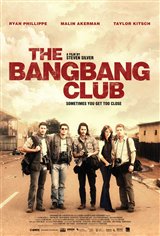The Bang Bang Club
Before the world knew who Kevin Carter, Greg Marinovich, Ken Oosterbroek and Joao Silva were, everyone knew their photographs. Before the world truly understood the horror of apartheid, its violence had been exposed by the work of these extraordinary young men. On September 15th, 1990, Marinovich took a series of photographs for Associated Press which included the image of an ANC supporter hacking at a burning man. (Inhlazane, Soweto, Sept 15, 1990). The photograph won Marinovich a Pultizer prize.
In May 1994, Carter won the Pulitzer for a picture first published in The New York Times of a starving Sudanese girl who collapsed on her way to a feeding center while a vulture stood on the ground a few feet away, waiting for her to die. Carter, who waiting 20 minutes for the vulture to spread his wings (it didn't) and eventually shooed it away, was criticized for not helping the tiny girl, who appeared to be not much older than a toddler. The St. Petersburg Times in Florida wrote about Carter: "The man adjusting his lens to take just the right frame of her suffering, might just as well be a predator, another vulture on the scene." After the photo was published, hundreds of people wrote The New York Times to ask if the child had survived, which lead to the newspaper publishing a special editor's note saying that according to Cartner, the girl had enough strength to resume her walk to the feeding center, but that her ultimate fate was unknown.
On April 18, 1994, nine days before South African first democratic elections, the Bang Bang Club were covering the violence in Thokoza township when Oosterbroek was killed in the crossfire between hostel dwellers and a South African peacekeeping force. Marinovich was wounded that same day.
Two months later, Carter, at the age of 33, took his own life. "I am depressed ... without phone ... money for rent ... money for child support ... money for debts ... money!!! ... I am haunted by the vivid memories of killings and corpses and anger and pain, of starving or wounded children, of trigger-happy madmen, often police, of killer executioners...I have gone to join Ken if I am that lucky."—from Kevin Carter's suicide note. He left behind a six-year-old daughter.
In 1994 Time magazine published an article entitled 'The Life and Death of Kevin Carter,' which told the story of the South African photojournalist. It caught the attention of writer/director Steven Silver.
"It was an intriguing story," said Silver. "I was in South Africa at the time, shooting another film, and I looked up Greg Marinovich and Joao Silva and we met. They talked to me about how this wasn't just a story about Kevin, but a story about four young men who had banded together in the beginning out of safety, and then after a period of time they had developed a reputation as these remarkable photographers, eventually nicknamed 'The Bang Bang Club.' It sounded like a great film and that it was true was an added bonus."
In 2000, Marinovich and Silva published 'The Bang-Bang Club: Snapshots from a Hidden War,' a book documenting their experiences.
